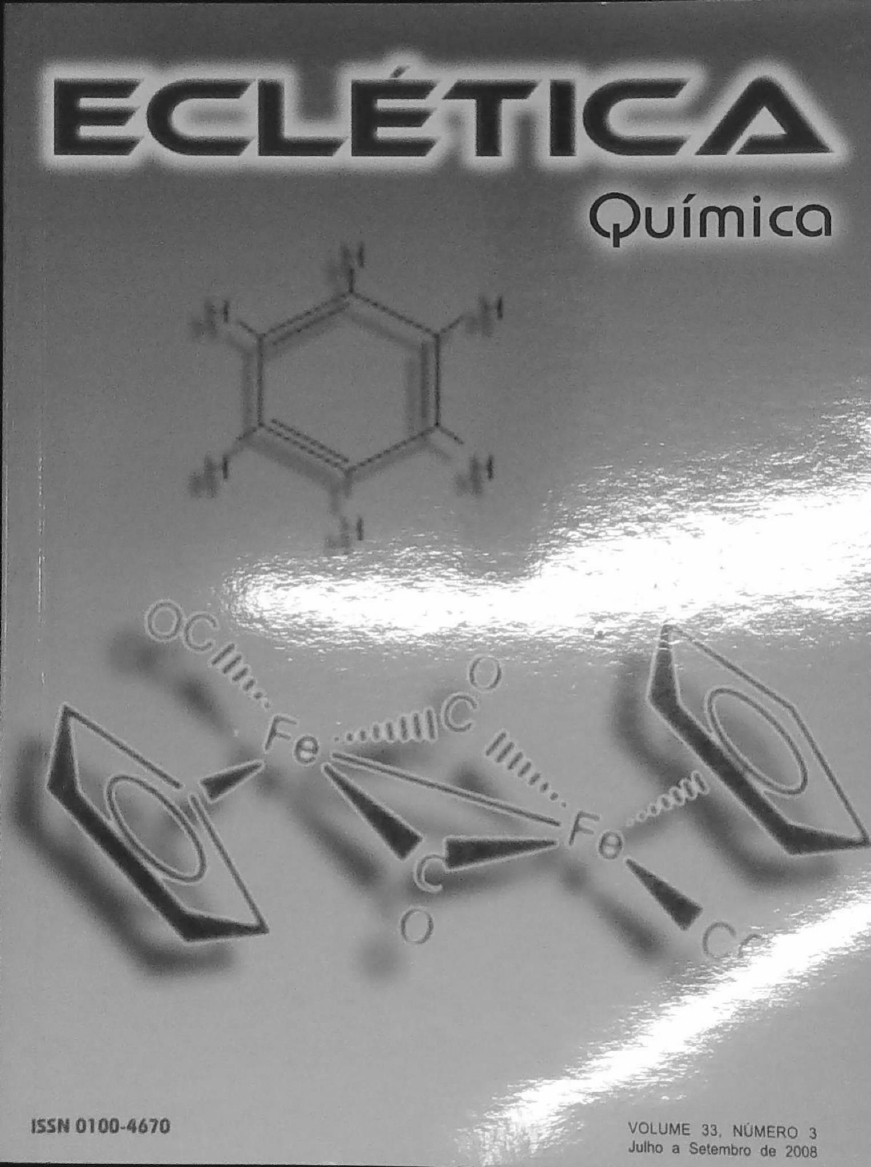Abstract
Quantum Chemical calculations for group 14 elements of Periodic Table (C, Si, Ge, Sn, Pb) and their functional groups have been carried out using Density Functional Theory (DFT) based reactivity descriptors such as group electronegativities, hardness and softness. DFT calculations were performed for a large series of tetracoordinated Sn compounds of the CH3SnRR’X type, where X is a halogen and R and R’ are alkyl, halogenated alkyl, alkoxy, or alkyl thio groups. The results were interpreted in terms of calculated electronegativity and hardness of the SnRR’X groups, applying a methodology previously developed by Geerlings and coworkers (J. Phys. Chem. 1993, 97, 1826). These calculations allowed to see the regularities concerning the influence of the nature of organic groups RR’ and inorganic group X on electronegativities and hardness of the SnRR’X groups; in this case, it was found a very good correlation between the electronegativity of the fragment and experimental 119Sn chemical shifts, a property that sensitively reflects the change in the valence electronic structure of molecules.
References
F.De Proft, W.Langenaeker , P.Geerlings, J.Phys.Chem. 97 (1993) 1826.
P.Geerlings, F. De Proft, W. Langenaeker Chem Rev. 103,
, (2003).
a. For a series of papers covering various aspects of electronegativity see: Structure and Bonding, Vol.66, Sen, K.D.; JØrgensen, C.K., Editors, Springer Verlag, Berlin, 1987; b. P. Gerrlings, F. De Proft. Int. J. Mol. Sci. 3, 276, (2002).
J. Mullay in Electronegativity,K.D..Sen and C.K Jorgenson Eds, Springer Velag,Berlin Heidelberg, 1987.
P. R.Wells,Progr. Phys.Org.Chem, 6, 111, (1968).
N. Inamoto, S. Masuda, Tetrahedron Lett, 3287 (1977).
R. P. Iczkowski and J. L. Margrave, J. Am. Chem. Soc.,83,
(1961).
R. G. Parr,R. A. Donnelly, M. Levy, W. E. Palke, J. Chem.
Phys. 68, 380, (1978).
R. G.Parr and W.Yang, Density Functional Theory of
Atoms and Molecules, Oxford University Press, New York,1989.
P. Geerlings, F.De Proft and W.Langenaeker, in Density
Functional Methods and Material Science, M.Sprinborg Eds, John Willey,1997,p 19
R. G. Pearson, J.Am.Chem.Soc., 85,3533(1963).
R. G. Parr and R. G. Pearson, J.Am.Chem.Soc., 105,7512
(1983).
B. Wrackmeyer. Annual Reports NMR Spectroscopy.16
(1985) 73.
B. Wrackmeyer. Annual Reports NMR Spectroscopy.38
(1999) 204.
a. R. Vivas-Reyes, F. De Proft, M. Biesemans, R. Willen,
P. Geerling, J. Phys. Chem. A 106, 2753, (2002) b. P.
Geerlings, R. Vivas-Reyes, F. De Proft, M. Biesemans, R.
Wiley. Metal-Ligands Interactions Molecular, Nano-Micro
and macro systems in Complex Enviroments. Nato Science
Series. 461, 2002.
A. Rodríguez-Fortea, P. Alemany, T. Ziegler. J. Phys.
Chem A. 103, 8288, (1999).
T. Helgager, M. Jaszunski, K. Ruud. Chem. Rev. 99, 293
(1999).
D. N. kravtsov, A. S. Peregudov, A. I. Krylova, and
Yu.Yu. Gorelikova., Russ. Chem. Bull., 46 (1997) 1167.
D. N. Kravtsov, A. S.Peregugudov and E. M.Rokhlina, J.
Organomet. Chem.,128(1977) C27.
D. N. Kravtsov, A. S. Peregudov, O. V. Shcherbakova and
Yu. A. Borisov, Russ. Chem. Bull., 44 (1995) 1841.
D. N. kravtsov, A.S.Peregudov, V. M. Pachevskaya,
L.S.Golovchenko., J. Organomet. Chem.,536 (1997) 385.
A. S. Peregudov, E. M. Rokhlina, D. N. kravtsov., J.
Organomet. Chem.,471(1994) C1.
R. S.Mulliken., J. Chem.Phys. 2 (1934) 782.
R. T. Sanderson, Chemical Bonds and Bond Energy,
Academic Press, New York 1976.
W. Yang and R. G. Parr.,Proc.Natl. Acad. Sci.USA.,82
(1985) 6723.
G. Schaftenaar and J. H. Noordock. J. Compt. Aided Mol
Desig. 14 (2000) 123.
a) Becke, A. D. J. Chem. Phys.1993, 98, 5648. b) Lee, C.
Yang. W. Parr. R. G. Phys. Rev. B. 1998, 37, 785 c) Stephens,
P.J.; Devlin, F. J.; Chabalowski, C.F.; Frisch, M.J. J. Phys.
Chem. 1994, 98, 11623.
Perdew, J. P, Wang, Y. Hys. Rev. B. 45, 13244, (1992).
Hehre,W. J.;Radom, L.;Schleyer, P.v.R.,J. A. Pople Ab
Initio Molecular Orbital Theory; Wiley: New York, 1986.
M. J. Frisch, G. W.Trucks, H. B. Sclhegel, P.M. W. Gill,
B. G. Johnson, J. A. Montgomery, K. Raghavachari, M. A. Al-
Laham, V. G. Zakrzewski, J. V. Ortiz, J. B. Foresman, J.
Cioslowski, B. B. Stefanov, A. Nanayakkara, M. Challacombe, C. Y. Peng, P. Y. Ayala, W. Chen, M. W. Wong, J. L. Andres, E. S. Replogle, R.Gomperts, R. L. Martin, D. J. Fox, J. S. Binkley, D. J. Defrees, J. Baker, J. PStewart, M. Head-Gordon, C. Gonzalez, and J. A. Pople, Gaussian 94, C.3Gaussian, Inc., Pittsburgh PA, 1995.
A. L .Allred, J. Inorg.Nucl.Chem., 17 (1961) 215.
R. G. Pearson, Inorg.Chem 27 (1988) 734.

This work is licensed under a Creative Commons Attribution 4.0 International License.
Copyright (c) 2018 Eclética Química Journal





